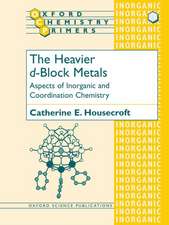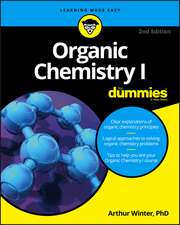Transition Metals in Supramolecular Chemistry: Nato Science Series C:, cartea 448
Editat de L. Fabbrizzi, Antonio Poggien Limba Engleză Paperback – 6 dec 2010
Transition Metals in Supramolecular Chemistry focuses on the following main topics: (1) metal controlled organization of novel molecular assemblies and shapes; (2) design of molecular switches and devices operating through metal centres; (3) supramolecular catalysts that mimic metalloenzymes; (4) metal-containing sensory reagents and supramolecular recognition; and (5) molecular materials that display powerful electronic, optoelectronic and magnetic properties.
| Toate formatele și edițiile | Preț | Express |
|---|---|---|
| Paperback (1) | 1224.54 lei 6-8 săpt. | |
| SPRINGER NETHERLANDS – 6 dec 2010 | 1224.54 lei 6-8 săpt. | |
| Hardback (1) | 1230.84 lei 6-8 săpt. | |
| SPRINGER NETHERLANDS – 31 oct 1994 | 1230.84 lei 6-8 săpt. |
Din seria Nato Science Series C:
- 24%
 Preț: 797.69 lei
Preț: 797.69 lei - 18%
 Preț: 957.62 lei
Preț: 957.62 lei - 18%
 Preț: 957.13 lei
Preț: 957.13 lei - 18%
 Preț: 1227.52 lei
Preț: 1227.52 lei -
 Preț: 396.40 lei
Preț: 396.40 lei -
 Preț: 403.75 lei
Preț: 403.75 lei - 18%
 Preț: 1239.37 lei
Preț: 1239.37 lei - 18%
 Preț: 1236.51 lei
Preț: 1236.51 lei - 18%
 Preț: 1231.78 lei
Preț: 1231.78 lei - 18%
 Preț: 1229.10 lei
Preț: 1229.10 lei - 18%
 Preț: 1835.21 lei
Preț: 1835.21 lei - 24%
 Preț: 1076.39 lei
Preț: 1076.39 lei -
 Preț: 390.46 lei
Preț: 390.46 lei -
 Preț: 369.63 lei
Preț: 369.63 lei - 18%
 Preț: 1232.41 lei
Preț: 1232.41 lei -
 Preț: 394.51 lei
Preț: 394.51 lei - 18%
 Preț: 1226.24 lei
Preț: 1226.24 lei - 18%
 Preț: 1845.80 lei
Preț: 1845.80 lei -
 Preț: 399.88 lei
Preț: 399.88 lei -
 Preț: 384.28 lei
Preț: 384.28 lei -
 Preț: 390.88 lei
Preț: 390.88 lei -
 Preț: 381.19 lei
Preț: 381.19 lei - 18%
 Preț: 1848.64 lei
Preț: 1848.64 lei - 18%
 Preț: 951.14 lei
Preț: 951.14 lei - 18%
 Preț: 1230.35 lei
Preț: 1230.35 lei - 18%
 Preț: 1236.51 lei
Preț: 1236.51 lei -
 Preț: 401.03 lei
Preț: 401.03 lei -
 Preț: 406.25 lei
Preț: 406.25 lei - 18%
 Preț: 1230.84 lei
Preț: 1230.84 lei -
 Preț: 418.34 lei
Preț: 418.34 lei - 18%
 Preț: 1223.74 lei
Preț: 1223.74 lei
Preț: 1224.54 lei
Preț vechi: 1493.34 lei
-18% Nou
Puncte Express: 1837
Preț estimativ în valută:
234.35€ • 243.76$ • 193.47£
234.35€ • 243.76$ • 193.47£
Carte tipărită la comandă
Livrare economică 15-29 aprilie
Preluare comenzi: 021 569.72.76
Specificații
ISBN-13: 9789048144839
ISBN-10: 9048144833
Pagini: 460
Ilustrații: XXII, 436 p.
Dimensiuni: 155 x 235 x 24 mm
Greutate: 0.64 kg
Ediția:Softcover reprint of hardcover 1st ed. 1995
Editura: SPRINGER NETHERLANDS
Colecția Springer
Seria Nato Science Series C:
Locul publicării:Dordrecht, Netherlands
ISBN-10: 9048144833
Pagini: 460
Ilustrații: XXII, 436 p.
Dimensiuni: 155 x 235 x 24 mm
Greutate: 0.64 kg
Ediția:Softcover reprint of hardcover 1st ed. 1995
Editura: SPRINGER NETHERLANDS
Colecția Springer
Seria Nato Science Series C:
Locul publicării:Dordrecht, Netherlands
Public țintă
ResearchCuprins
Supramolecular photochemistry and photophysics. Energy conversion and information-processing devices based on transition metal complexes.- Transition metal redox active ligand systems for recognising cationic and anionic guest species.- Ligand design for enhanced molecular organization — selectivity and specific sequencing in multiple receptor ligands, and orderly molecular entanglements.- Metal-ions: a self-assembly motif in supramolecular oligomers.- Biomedical targeting: a role for supramolecular chemistry.- Redox chemistry of metal ion complexes: preparation of new materials.- pH and redox switches based on metal centres.- Schiff base macrocycles and metallo-biosite modelling.- Self-assembly of mono- and dinuclear metal complexes; oxidation catalysis and metalloenzyme models.- Artificial porphyrins containing cyclopropane units functioning as electron shuttles.- Homo- and heterobinuclear metal complexes with bismacrocyclic ligands.- Ferrocene as a building block for supramolecular chemistry systems.- Macrocyclic polyamine complexes beyond metalloenzyme models.- Towards molecular wires and switches: exploiting coordination chemistry for non-linear optics and molecular electronics.- Molecular interactions between metalloproteins involved in electron transfer processes: tetraheme cytochrome c3 and flavodoxin. NMR and molecular modeling studies.- Supramolecular models of metallo-proteins.- The role of macrocyclic receptors in organization of metal centres.- Metallomacrocycles and -clefts: receptors for neutral molecules and anions.- Chiral recognition by functionalized cyclodextrin metal complexes.- Transition metal-directed threading and knotting processes.- Expanded porphyrins. Receptors for cationic, anionic and neutral substrates.- Following the self-assemblyprocess in solution.- Author Index.
Recenzii
` ... this book is recommended to all who are interested in the role of transition metals in the many subfields of supramolecular chemistry.'
Recueil des Travaux chimiques des Pays-Bas, 115/02
Recueil des Travaux chimiques des Pays-Bas, 115/02








